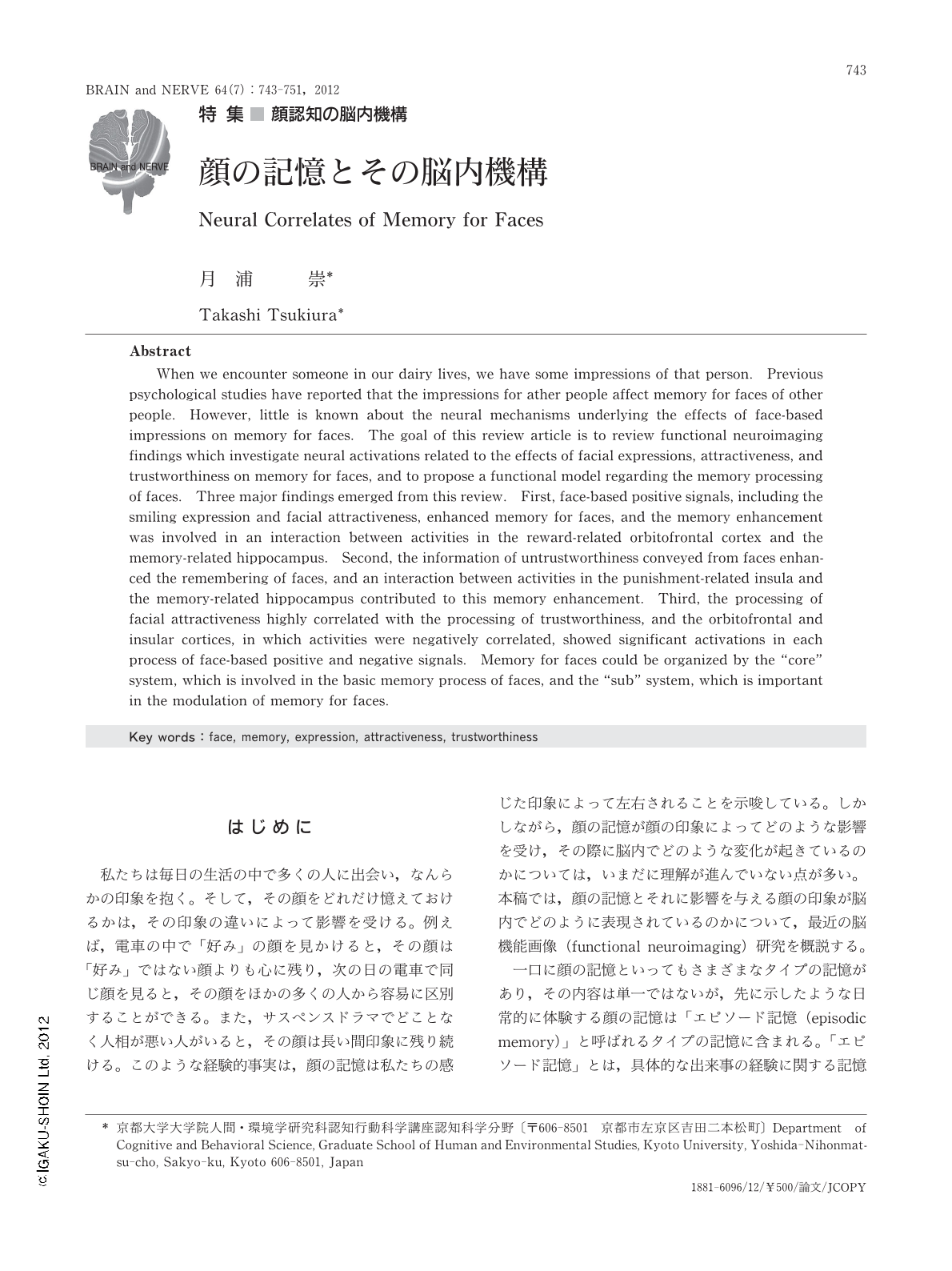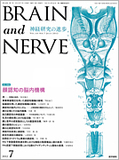Japanese
English
- 有料閲覧
- Abstract 文献概要
- 1ページ目 Look Inside
- 参考文献 Reference
はじめに
私たちは毎日の生活の中で多くの人に出会い,なんらかの印象を抱く。そして,その顔をどれだけ憶えておけるかは,その印象の違いによって影響を受ける。例えば,電車の中で「好み」の顔を見かけると,その顔は「好み」ではない顔よりも心に残り,次の日の電車で同じ顔を見ると,その顔をほかの多くの人から容易に区別することができる。また,サスペンスドラマでどことなく人相が悪い人がいると,その顔は長い間印象に残り続ける。このような経験的事実は,顔の記憶は私たちの感じた印象によって左右されることを示唆している。しかしながら,顔の記憶が顔の印象によってどのような影響を受け,その際に脳内でどのような変化が起きているのかについては,いまだに理解が進んでいない点が多い。本稿では,顔の記憶とそれに影響を与える顔の印象が脳内でどのように表現されているのかについて,最近の脳機能画像(functional neuroimaging)研究を概説する。
一口に顔の記憶といってもさまざまなタイプの記憶があり,その内容は単一ではないが,先に示したような日常的に体験する顔の記憶は「エピソード記憶(episodic memory)」と呼ばれるタイプの記憶に含まれる。「エピソード記憶」とは,具体的な出来事の経験に関する記憶であり,通常その出来事の内容(「何の」経験だったか)に加えて,出来事を経験したときの付随情報である時間(「いつ」経験したことか)や場所(「どこで」経験したことか)などの文脈(context)に関する情報が含まれている記憶のことを指す1)。顔の記憶の場合,「顔」の情報が出来事の内容になり,出会った場所(例えば「電車の中」)や出会った時間(例えば「早朝」)が文脈の情報となる。
エピソード記憶の脳内機構に関する研究は,症例H.M.に関する報告以来2),側頭葉内側面(海馬・海馬傍回:Fig.1)に損傷をもった症例を対象として行われてきた。しかし,近年になって機能的磁気共鳴画像法(functional magnetic resonance imaging:fMRI)などの脳機能画像法の技術が開発されると,脳に損傷を持たない健康なヒトを対象として,ほぼ非侵襲的にエピソード記憶課題遂行中の神経活動のパターンを,脳血流量の増減を媒体として可視化できるようになり,世界中の多くの研究施設でヒトのエピソード記憶の脳内機構解明のツールとして用いられるようになっている。
Abstract
When we encounter someone in our dairy lives,we have some impressions of that person. Previous psychological studies have reported that the impressions for ather people affect memory for faces of other people. However,little is known about the neural mechanisms underlying the effects of face-based impressions on memory for faces. The goal of this review article is to review functional neuroimaging findings which investigate neural activations related to the effects of facial expressions,attractiveness,and trustworthiness on memory for faces,and to propose a functional model regarding the memory processing of faces. Three major findings emerged from this review. First,face-based positive signals,including the smiling expression and facial attractiveness,enhanced memory for faces,and the memory enhancement was involved in an interaction between activities in the reward-related orbitofrontal cortex and the memory-related hippocampus. Second,the information of untrustworthiness conveyed from faces enhanced the remembering of faces,and an interaction between activities in the punishment-related insula and the memory-related hippocampus contributed to this memory enhancement. Third,the processing of facial attractiveness highly correlated with the processing of trustworthiness,and the orbitofrontal and insular cortices,in which activities were negatively correlated,showed significant activations in each process of face-based positive and negative signals. Memory for faces could be organized by the "core" system,which is involved in the basic memory process of faces,and the "sub" system,which is important in the modulation of memory for faces.

Copyright © 2012, Igaku-Shoin Ltd. All rights reserved.


